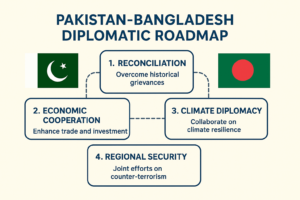Ties that Bind: Pakistan–Bangladesh Relations
(Based on Dawn Editorial, 26 Aug 2025)
Overview
Pakistan and Bangladesh share deep cultural, religious, and historical ties, but their relationship has remained strained due to the legacy of 1971. Recent initiatives by Dhaka’s interim administration point to a renewed spirit of cooperation, creating space for dialogue on trade, climate diplomacy, and regional security. For Pakistan, this episode illustrates the need for reconciliation, pragmatic diplomacy, and strong governance in managing foreign policy. The editorial is highly relevant for CSS aspirants as it reflects South Asian geopolitics, diplomacy, and regional integration—frequent themes in CSS exams.
Brief Description
The editorial underscores the significance of improving Pakistan–Bangladesh ties under Dhaka’s interim administration, emphasizing reconciliation, economic cooperation, and regional peace while highlighting persistent challenges rooted in history and politics.
Outline
I. Introduction
II. Historical Context of Relations
III. Current Diplomatic Thaw
IV. Strategic Opportunities
1. Economic & Trade Cooperation
2. Climate Change & Water Management
3. Regional Security Collaboration
V. Challenges & Constraints
VI. Implications for Pakistan
VII. Lessons for Governance & Diplomacy
VIII. CSS Relevance
IX. Key Vocabulary
X. Important Questions (MCQs + Analytical)
XI. Conclusion
Expanded Write-up
I. Introduction
Diplomacy in South Asia often oscillates between conflict and cooperation. Pakistan–Bangladesh relations are a prime example of how historical grievances shape present policy. The latest moves from Dhaka’s interim government have rekindled hopes for rapprochement.
II. Historical Context of Relations
Since 1971, relations between the two states have been punctuated by mistrust and diplomatic distance. Attempts at normalization faced hurdles from political sensitivities and domestic opposition in both countries.
III. Current Diplomatic Thaw
The interim administration in Dhaka has initiated confidence-building measures, opening dialogue on trade, regional connectivity, and cultural exchange. Symbolically, this marks a break from decades of bitterness.
IV. Strategic Opportunities

- Economic & Trade Cooperation – Opening transit routes could boost bilateral trade and integrate Pakistan into Bay of Bengal markets.
- Climate Change & Water Management – Both countries face similar vulnerabilities to floods and rising sea levels, offering opportunities for shared research and adaptation strategies.
- Regional Security Collaboration – Joint efforts against terrorism and transnational crimes could reinforce regional stability.
V. Challenges & Constraints
- Historical Grievances: The 1971 war remains a sensitive political memory.
- Domestic Opposition: Hardline groups in both countries resist reconciliation.
- Regional Pressures: India’s role in Bangladesh’s politics complicates Pakistan’s outreach.
VI. Implications for Pakistan
- Pakistan must adopt a forward-looking policy that acknowledges history without being trapped by it.
- Building economic diplomacy through joint ventures and trade routes can reduce dependence on a few markets.
- Leveraging soft power tools like education scholarships, cultural exchanges, and media collaboration can reshape perceptions.
- Improved relations can also strengthen Pakistan’s regional standing in SAARC and IORA.
VII. Lessons for Governance & Diplomacy
- Pragmatism over emotional politics.
- Institutionalised foreign-office dialogue mechanisms.
- Investing in climate diplomacy as a new frontier of cooperation.
VIII. CSS Relevance
- Essay paper: “South Asian Regionalism and Pakistan’s Role”
- IR optional: Pakistan’s Bilateral Relations
- Current Affairs: Regional Diplomacy & Geopolitics
- Precis & Composition: Vocabulary usage from editorials
Key Vocabulary (with usage)
| Word | Meaning | Usage in Sentence |
|---|---|---|
| Rapprochement | Renewal of friendly relations | The interim government in Dhaka has opened doors for rapprochement with Pakistan. |
| Thaw | Easing of strained relations | The recent diplomatic thaw offers space for dialogue. |
| Reconciliation | Restoration of friendship | National interests demand reconciliation beyond historical bitterness. |
| Pragmatism | Practical approach | Pakistan’s diplomacy must be guided by pragmatism, not sentiment. |
| Geopolitics | Political influence of geography | Bangladesh’s location enhances its role in South Asian geopolitics. |
| Confidence-building | Steps to reduce mistrust | Trade initiatives act as confidence-building measures. |
| Vulnerability | State of being exposed to risks | Both countries share vulnerability to floods and cyclones. |
| Legacy | Historical inheritance | The legacy of 1971 continues to shape perceptions. |
Important Questions
MCQs
- Which concept best describes the improvement in Pakistan–Bangladesh ties?
A. Estrangement
B. Rapprochement
C. Hostility
D. Disengagement
Answer: B - Which common challenge pushes Pakistan and Bangladesh towards cooperation?
A. Oil shortages
B. Climate change vulnerability
C. Nuclear proliferation
D. Border wars
Answer: B - The editorial highlights Dhaka’s initiative under which administration?
A. Civilian elected government
B. Interim administration
C. Military junta
D. Coalition government
Answer: B
Analytical Questions (for CSS Essays/CA)
- Critically examine the role of historical grievances in shaping Pakistan–Bangladesh relations.
- How can climate diplomacy become a new foundation for South Asian cooperation?
- Evaluate the geopolitical significance of Bangladesh for Pakistan’s regional integration.
Conclusion
Pakistan and Bangladesh stand at a historic crossroads. By choosing reconciliation over estrangement, both countries can unlock economic, strategic, and cultural opportunities. For Pakistan, this requires mature diplomacy, visionary governance, and pragmatic foreign policy—all of which are central themes for CSS aspirants preparing to analyze South Asia’s complex geopolitics.

